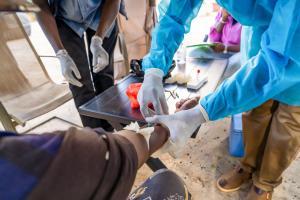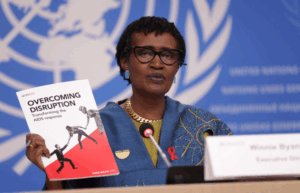Despite significant progress since the turn of the century, a new United Nations assessment indicates that improvements in global health are stalling. With just five years left to meet the 2030 Agenda—a global action plan adopted in 2015 to ensure sustainable development—population health worldwide is advancing at a snail’s pace.
Sustainable Development Goal (SDG) 3, which focuses on health and well-being, aims by 2030 to reduce maternal and child mortality, end major epidemics, strengthen health systems, expand access to care, and promote mental health.
However, according to an annual progress report released this week, only one-third of SDG 3 targets are on track or showing moderate progress. The rest are either making minimal progress or stagnating.
As the High-Level Political Forum on Sustainable Development—an annual UN platform for reviewing the 2030 Agenda—meets from July 14 to 23 in New York, member states are taking stock of the uneven and concerning progress in global health.
A Sharp Slowdown After Two Decades of Gains
From 2000 to 2019, key indicators showed promise: maternal and child mortality declined, HIV incidence dropped, and healthy life expectancy increased by five years. But the COVID-19 pandemic reversed some of those gains, cutting global life expectancy by 1.8 years and disrupting health initiatives worldwide.
Both infectious and non-communicable diseases remain the two major threats. In 2023, tuberculosis overtook COVID-19 as the top infectious disease killer. Meanwhile, non-communicable diseases—cancer, diabetes, cardiovascular diseases—still account for over half of deaths among people under 70 globally.
Maternal and Child Mortality: Progress Slowing
The global maternal mortality rate fell from 228 to 197 deaths per 100,000 live births between 2015 and 2023. However, that’s still nearly three times higher than the UN’s target. Achieving the 2030 goal would require an annual reduction of 14.8%—far above current trends. Sub-Saharan Africa and South Asia account for 87% of maternal deaths, with minimal progress recorded in those regions since 2015.
Child mortality tells a similar story: while the death rate for children under five dropped to 37 per 1,000 live births, progress is slowing sharply. The disparity between rich and poor nations remains vast—a child born in sub-Saharan Africa is 18 times more likely to die before their fifth birthday than one born in Australia or New Zealand.
HIV, Tuberculosis, Malaria: Fragile Gains
Efforts to combat HIV/AIDS have halved deaths since 2010. Still, 9.3 million people lacked access to life-saving treatments in 2023, most of them in Africa. Funding is also drying up: the suspension of U.S. aid in January 2025 puts treatment access in 55 countries—mostly in Africa—at risk.
Tuberculosis continues to claim lives: 10.8 million cases were reported in 2023, mostly in 30 high-burden countries. Although annual deaths have dropped below pre-pandemic levels (1.25 million), the current decline in incidence is insufficient to meet global goals by 2030.
Malaria is on the rise again: an estimated 263 million cases in 2023, up from 226 million in 2015. Gaps in prevention are to blame. Over 40% of pregnant women and children under five in sub-Saharan Africa still lack access to insecticide-treated mosquito nets, which are essential for protection.
Non-Communicable Diseases: Leading Cause of Premature Death
In 2021, 18 million people under 70 died from non-communicable diseases. While premature mortality had declined in the 2000s, progress has stalled since 2020. At this rate, the UN goal to cut such deaths by one-third by 2030 will not be met.
Tobacco use, though down globally (118 million fewer smokers since 2005), remains a major concern. Environmentally, cigarette butts are the second-largest source of plastic pollution globally, and tobacco farming contributes to deforestation and CO₂ emissions. Alcohol consumption has slightly decreased on average, but health impacts remain severe, particularly in Africa and Europe.
Mental Health: Suicide Rates Down Globally, But Regional Surges Worry
Global suicide rates fell from 12.5 to 9.2 per 100,000 people between 2000 and 2021. However, some regions are seeing alarming increases—North America (+33%) and Latin America (+25%) in particular. People in low- and middle-income countries account for 73% of suicide deaths. The World Health Organization (WHO) is urging political action, backed by targeted prevention campaigns.
Contraception, Teen Births, and Vaccination: Uneven Progress
The proportion of women whose contraceptive needs are met by modern methods has reached 77.2% globally, with notable improvements in sub-Saharan Africa. Teen pregnancy has also declined—from 13.9 to 12.4 million births annually between 2015 and 2024.
But childhood vaccination programs are still recovering from the pandemic. Coverage for the DTP3 vaccine has stalled at 84%, below pre-2020 levels. Vaccination against human papillomavirus (HPV)—critical for preventing cervical cancer—remains low. Meanwhile, measles outbreaks are on the rise in many countries due to insufficient vaccine coverage.
Funding Declines, Workforce Shortages Persist
Official development assistance for health dropped by 39% between 2022 and 2023, from $22.1 billion to $13.4 billion. The least developed countries received $5.5 billion, or 40% of the total—a 20% decrease.
While the global health workforce now exceeds 70 million, shortages remain severe: 14.7 million positions are still unfilled, mostly in Africa.
Five Years to Change Course
This sobering assessment underscores persistent divides in global health. As the 2030 Agenda enters its final stretch, the UN is calling for bold investments, equity-driven policies, and a massive scale-up of primary health care.
Without accelerated action, 30 million children could die before their fifth birthday by 2030. Millions more—women, adolescents, people living with HIV or chronic illnesses—could remain excluded from essential health care. The world has five years left to reverse the trend.







OTHER ARTICLES
Zambia : Health Sector Progress Update
Rift Valley Fever in Senegal: On the Frontline to Protect Communities
Zambia : commemorates world AIDS day